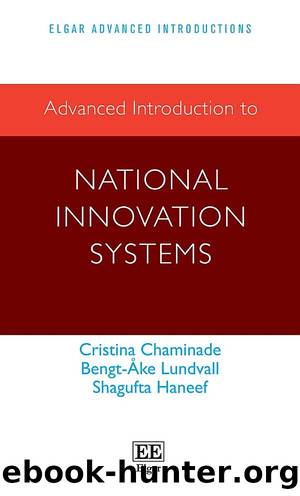Advanced Introduction to National Innovation Systems by Cristina Chaminade & Bengt-Åke Lundvall & Shagufta Haneef

Author:Cristina Chaminade & Bengt-Åke Lundvall & Shagufta Haneef
Language: eng
Format: epub
ISBN: 9781785362026
Published: 2018-05-11T00:00:00+00:00
8.2 Understanding sustainable development as a nested model
Probably one of the most widely used definitions of sustainable development is that first introduced in the Brundtland report:
Sustainable development is development that meets the needs of the present without compromising the ability of future generations to meet their own needs. It contains within it two key concepts: the concept of âneedsâ, in particular the essential needs of the worldâs poor, to which overriding priority should be given; and the idea of limitations imposed by the state of technology and social organization on the environmentâs ability to meet present and future needs ⦠Development involves a progressive transformation of economy and society. A development path that is sustainable in a physical sense could theoretically be pursued even in a rigid social and political setting. But physical sustainability cannot be secured unless development policies pay attention to such considerations as changes in access to resources and in the distribution of costs and benefits. Even the narrow notion of physical sustainability implies a concern for social equity between generations, a concern that must logically be extended to equity within each generation. (Brundtland and Khalid, 1987, p. 1)1
While for many scholars and practitioners, sustainable development refers to economic, social and environmental sustainability in more or less equal terms (UNEP, 2015), scholars in sustainability science adopt a nested model in which sustainable development is about ensuring human wellbeing while safeguarding sustained services by the environment (Folke et al., 2011; Figure 8.1). In other words, it is about finding a safe operating space that allows economic and social wellbeing for the entire population while safeguarding the capacity for the planet to continue providing for future generations.
Graphically, this nested model can be represented as a doughnut where the inner circle epitomizes economic and social wellbeing within the capacity of the planet to provide goods and services to sustain life (Raworth, 2017). Obviously, innovation plays a fundamental role in achieving this goal by enabling economic and inclusive development without crossing the planetary boundaries or even more ambitiously bending the trend. Understanding sustainable development this way has important implications for the way that we think about sustainable, ecological or environmental innovations. The aim is not simply reducing the environmental impact of a particular product or process, but ensuring social and economic welfare within the planetary boundaries.2 This change of perspective is more fundamental than what meets the eye, as discussed in Box 8.1.
The nested model suggested above might be very appealing since it puts economic and inclusive development into the boundaries of our natural world but it can be interpreted in two ways. In a narrow perspective, it can be used to discuss how innovation can help reduce the environmental impact or the resource constraints of the current models of production and consumption and economic and social wellbeing. This, as we have discussed in Box 8.1, will not suffice to ensure that humanity remains in the safe operating space which is the Holocene. In a broader perspective, it can illustrate the
Download
This site does not store any files on its server. We only index and link to content provided by other sites. Please contact the content providers to delete copyright contents if any and email us, we'll remove relevant links or contents immediately.
Zero to IPO: Over $1 Trillion of Actionable Advice from the World's Most Successful Entrepreneurs by Frederic Kerrest(4053)
Machine Learning at Scale with H2O by Gregory Keys | David Whiting(3627)
Harry Potter and the Goblet Of Fire by J.K. Rowling(3609)
Never by Ken Follett(3528)
Ogilvy on Advertising by David Ogilvy(3331)
Shadow of Night by Deborah Harkness(3174)
The Man Who Died Twice by Richard Osman(2808)
Book of Life by Deborah Harkness(2719)
My Brilliant Friend by Elena Ferrante(2702)
How Proust Can Change Your Life by Alain De Botton(2613)
0041152001443424520 .pdf by Unknown(2595)
Will by Will Smith(2580)
The Tipping Point by Malcolm Gladwell(2559)
How to Pay Zero Taxes, 2018 by Jeff A. Schnepper(2500)
Purple Hibiscus by Chimamanda Ngozi Adichie(2484)
Hooked: A Dark, Contemporary Romance (Never After Series) by Emily McIntire(2421)
Rationality by Steven Pinker(2149)
Borders by unknow(2117)
Daughter of Smoke and Bone by Laini Taylor(2081)
